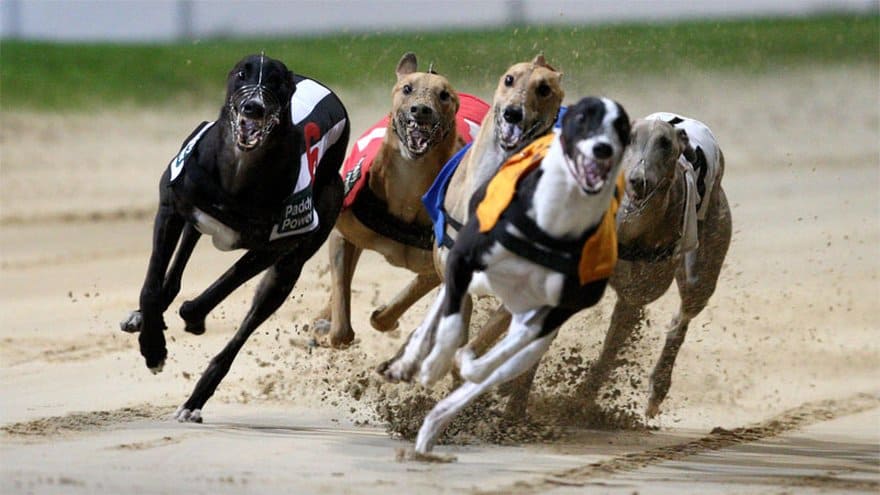Dog Racing Bet Types

Born to Run: The Greyhound Racing Association claims that Greyhounds do not run because they are forced to, they run because they love it. Although many opponents dispute this claim, or at least assert it has nothing to do with dog racing, few can deny that dogs love to run, especially Greyhounds - the instinct to run seems to be as old as the dog itself. Dogs like Greyhounds are generally easy going. That is until they see a potential prey, which works like a starter’s pistol and sends the hound off in a sprint.
A Lucky 15 bet requires you to make four different bets on four separate dogs, usually in different races. You will make 15 bets: straight bets on each of the four greyhounds, all six possible two-bet accumulators, all four three-bet accumulators, and a single fourfold accumulator. You make three individual bets on one dog to Win, Place, and Show. If your selection wins, you collect on all three bets. If your selection runs second, you collect on Place and Show bets. If your selection runs third, you collect the Show bet. Greyhound dog racing rules, how to bet, types of bets. Greyhound racing betting odds, with all UK and Irish dog meetings over the next 48 hours listed on the page. Find best odds on the next greyhound race off. Greyhound betting very closely resembles horse racing betting. All the same types of wagers that you could place on a horse race may also be placed on a dog race and greyhound racing betting uses the parimutuel form of wagering to calculate the odds and pay winners.
Want to Race: The Greyhound is the dog most closely associated with dog racing, although it’s disputable whether they are the fastest or not. Some claim the Saluki, a Middle Eastern dog trained to hunt, may be as fast, if not faster. Either way, both are terribly quick, capable of reaching over 40 mph. The Greyhound was also trained to hunt and did so on sight. They have a remarkably poor sense of smell, but will pursue most anything that moves.
Run Like an Egyptian: The Egyptians may have very well been the original dog racers. We know that dogs, and Greyhounds in particular, had a special place in Egyptian life. Dogs were permitted to share tents with humans and often given rides atop of camels. Archeologists have discovered murals and painting dating back to before 2,500 BC depicting elaborate dog races, run by dogs that look remarkably like our own Greyhounds. The Romans, Persians, and Greeks had similar attitudes towards our canine friends.
Dog racing was probably brought to the British Isles by the Romans, but we are not sure exactly when. We do know, that by the time of the Norman Invasion, Greyhounds were closely associated with the English aristocracy, and banned from commoners. It was in the 16 th century that Queen Elizabeth I established the first coursing rules. The race usually consisted of only two hounds, both chasing a hare that was given a 240-yard head start. Betting became more established as well, with not only the owners wagering large amounts, but spectators making bets on the side. Dog racing grew in popularity over the next two centuries. In 1837 the Waterloo Cup Meet was first held (a race that continues today) and had about 75,000 people attending the race by end of century.
Against All Odds: Dog racing in the U.S. probably began during the Civil War, especially in the West. George Custer was an avid dog owner and supposedly had 4 beautiful Greyhounds of his own. But it was Major James H. 'Hound Dog' Kelly who first began breeding and training Greyhounds. “In 1878, Kelly's team of four Greyhounds set what was considered a record by running down six out of a dozen antelopes. That's generally considered the start of American coursing.” (1) After the war, they were raised and even imported from England to help kill jackrabbits in the fields. Racing the dogs became a nice diversion for the people. The sport was becoming established.
Rascally Rabbit: In 1905, Owen Patrick Smith was charged with organizing a dog race by the city of Hot Springs, South Dakota in the hopes of attracting tourists to the town. Smith felt the sport was cruel and began thinking of ways to remedy the situation. He decided to have the dogs chase artificial rabbits and sent them along a circled rather than straight track.
How To Bet Dog Racing
Get Back to Work!: Racers were organized across the country and were most popular in Florida. As with many sports, it was most successful just after World War II. It was particularly popular with working men and women, so much so that employers complained to track owners that their employees missing work. But, as is often the case with such sports, dog racing had a dark underbelly. Betting became a large factor, and attracted some unseemly characters. There was, and remains, much talk about doping the dogs, and general abuse in their training.
Dog Racing Bet Types Crossword Clue

Dog Racing Bet Types Games
State Control: In the early 1990s over 3 million people attended dog races across the country, betting over $3 billion. But since then attendance has declined, often because of state control as well as protests from animal right’s activists. Most states have banned dog racing all together, and the few dog tracks that remain really make their money from slot machines.